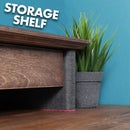Introduction: Plywood Spiral Staircase Display Stand
Spiral staircases are beautiful pieces of architecture. I was recently asked to make a spiralling display stand so of course I had to make it like a staircase. It's a really simple project and one that's ideal for people who need to display items for craft fairs. It really makes for a great display stand idea.
Supplies
Materials Used:
- Live Edge Oak - For The Base
- 18mm Birch Plywood
- 8mm Dowel
- Super Glue - For Filling Voids
- Super Glue - For Regular Use
- Spray Activator
- Wood Glue
Tools Used:
- Bandsaw
- Belt Sander
- Electric Sanders
- Drill
- Handsaw
Step 1: Prepare the Base
This project for me started with an off cut piece of live oak. I had this piece left from some shelves I made recently. It was ideal for a base to the spiralling display stand.
As the board roughly measured 26cm wide I measured and marked a rough 26cm square line on the board and cut it to length on the bandsaw. The oak did have some knots and voids that needed filling. I would usually fill these with either resin or an epoxy putty but I wanted to try something a little different on this project.
I saw this thick black super glue and thought it could work great. I often add black pigment to resin for filling voids so this would be an ideal fit. I added some of the super glue to the voids, allowed it to seep in and then sprayed some activator spray to help set the glue. I thought it would be set in a couple of minutes but it actually took closer to half an hour to fully dry. This is still loads faster than resin but not as fast as I thought.
Once fully set I could sand back the glue flush with the surface of the oak.
Step 2: Create the "Stairs"
Next up, it was time to make the steps to the plywood spiral staircase. 18mm plywood was ideal for these. I roughly marked out a pizza slice measuring 12cm long and 9cm wide at the widest point. The ends were given curves to add some detail to the shape. I also marked for an 8mm hole close to the thinner end of the pizza slice. This will receive a wooden dowel later. I cut this shape out on the bandsaw and refined the shape on the belt sander.
The first piece could be used to mark out the other pieces. Tracing them onto some 18mm plywood and then cutting and shaping them in the same way at the bandsaw and belt sander.
Step 3: Drill Holes & Assemble
With all the shapes cut and refined the next task is to drill the holes for the wooden dowel. I did this with an 8mm bit in my drill. I drilled the hole in my template piece first. I then used that piece as a guide to drill holes in all the other pieces. The last hole to drill was in the centre of the oak base piece. This hole doesn't go all the way through though. This will be where the wooden dowel connects to the base later.
It's the fun part next. It's time to create the spiral staircase. I placed an 8mm wooden dowel into the centre hole in the oak base piece. I could then add the first pizza wedge shape to the dowel. I don't glue this to the board just yet. I instead add some super glue to the far edge and then add a second pizza slice shape on top of it. I overlap each piece by 2cm at the outside edge. It's just a case of repeating this step until you have reached a height you're happy with.
The excess wooden dowel at the top can be cut flush with a handsaw and sanded smooth.
To glue the spiral to the oak base, I used both wood glue and super glue. The wood glue adds a lot of strength but takes time to set. The super glue sets really fast though, so using both together gives you the best of both worlds. The spray activator speeds up setting time even quicker too.
Step 4: Done
Usually at this stage I would apply a finish. I'd opt for a spray lacquer but this display stand was made for a friend and she wants to apply the finish herself so I have left it unfinished at this stage.
This display stand can be utilised for multiple use cases. You can of course adapt the sizing to best suit your needs. I really hope you liked it and give it a go for yourself.













